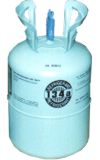MackFri - 134a
MackFri® - 134a
ASHRAE Name : R-134a
The Blends for replacement of R-12.
MackFri®-134a refrigerant. Chemical formula CF3CFH2 (tetrafluoroethane). R134a molecule has smaller size than R12 molecule which makes danger of leakage more considerable. Ozone depletion potential ODP=0, global warming potential GWP=1300. Physical qualities of R134a are given in table below.
R134a refrigerant is non-toxic and does not flare up within the whole range of operational temperatures. However, in case of air ingress into the system and compression there can be formed combustible blends. You shouldn't mix R134a with R12 because there is formed azeotrope blend of high pressure with mass proportions of the components 50 and 50%. Saturated vapor pressure of this refrigerant is a bit higher than that of R12 (correspondingly 1,16 and 1,08 МPа at 45 oС). R134a vapor is decomposed under the influence of flame with formation of poisonous and irritating contextures, such as fluorohydrogen.
According to classification ASHRAE, this product is related to class А1. In middle-temperature equipment (boiling point -7 oС and higher), R134a has operation performance close to R12.
 R134a is characterized by not high discharge temperature (it is approximately 8...10oС lower than for R12) and not high values of saturated vapors pressure. R134a is characterized by not high discharge temperature (it is approximately 8...10oС lower than for R12) and not high values of saturated vapors pressure.
In refrigeration facilities operating under boiling point lower than -15 oС, energy data of R134a are worse than those of R12 (specific volumetric refrigerating effect is 6% lower at -18 oС), and refrigerating factor. In such facilities it is purposeful to use refrigerants with lower normal boiling point or compressor with increased time volume circumscribed by pistons.
In middle temperature refrigeration facilities and air-conditioning systems, refrigerating factor of R134a is equal to the factor for R12 or higher than that.
Due to considerable global warming potential GWP, it is recommended to use R134a in hermetic refrigerating systems. Contribution of R134a to greenhouse effect is 1300 times as bigger as that of СО2. Thus, air venting of R134a one filling from a domestic refrigerator (about 140 gm) corresponds to ejection of 170 kg of СО2. In Europe about 448 gm of СО2 is formed at production of 1 kWt/h of power, that is, this ejection corresponds to production of 350 kWt*h of power.
For operation with R134a refrigerant, only polyester refrigeration oils characterized by increased hygroscopic property are recommended.
 R134a is widely used all over the world as a main substitute of R12 fir refrigeration equipment operating within middle-temperature range. It is used in automobile air-conditioners, domestic refrigerators, commercial refrigeration middle-temperature equipment, industrial facilities, air-conditioning systems in buildings and industrial areas, as well as on refrigeration transport. The refrigerant can be used also for retrophite of the equipment operating at lower temperatures. However, in this case, if the compressor is not substituted, refrigeration system can have reduced cold-productivity. R134a is widely used all over the world as a main substitute of R12 fir refrigeration equipment operating within middle-temperature range. It is used in automobile air-conditioners, domestic refrigerators, commercial refrigeration middle-temperature equipment, industrial facilities, air-conditioning systems in buildings and industrial areas, as well as on refrigeration transport. The refrigerant can be used also for retrophite of the equipment operating at lower temperatures. However, in this case, if the compressor is not substituted, refrigeration system can have reduced cold-productivity.
R134a is compatible with a number of sealing materials, in particular, with pads made of such materials as "Buna-N", "Khailalon 48", "Neopren", "Nordel".
At the same time, in water-cooling plants with screw and centrifugal compressors the use of R134a has certain perspectives.
Similar : FORANE®-134a, HFC-134a, SUVA-134a, Genetron-134a, Dymel-134a, Solkane-134a, Halocarbon-134a
Physical properties:
| Molecular weight |
102.03 |
| Boiling point under 1.013x105Pa,0C |
-26.1 |
| Density of liquuid at 250C,g/cm3 |
1.207 |
| Vapor pressure at 250C,MPa |
0.665 |
| Critical temperature, 0C |
101.1 |
| Critical pressure, MPa |
4.067 |
| Critical density, g/cm3 |
0.512 |
| Latent heat of vaporization at bp., KJ/Kg |
215.0 |
| Solubility in water at 250C, % by weight |
0.15 |
| Specific heat, liquid, 300C, KJ/Kg.0C |
1.51 |
|
Safety:
| Ozone-Depletion Potential (ODR) |
0 |
| Global Warming Potential (GWP) |
0.29 |
|
|



